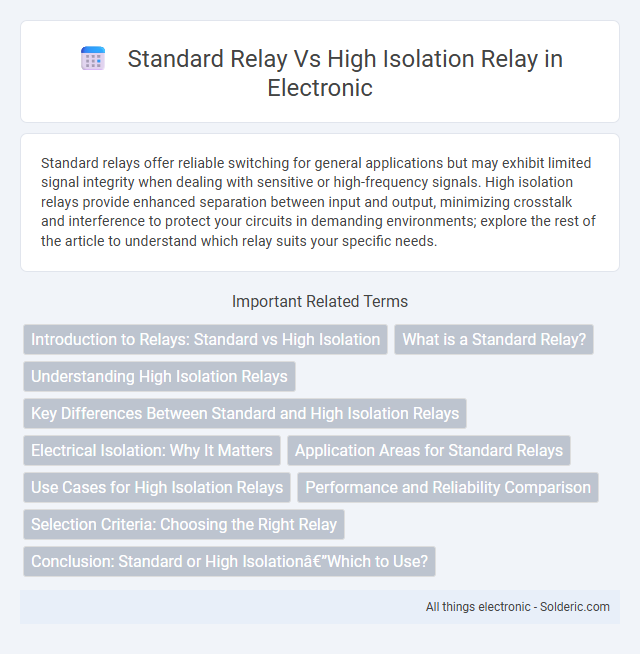Standard relays offer reliable switching for general applications but may exhibit limited signal integrity when dealing with sensitive or high-frequency signals. High isolation relays provide enhanced separation between input and output, minimizing crosstalk and interference to protect your circuits in demanding environments; explore the rest of the article to understand which relay suits your specific needs.
Comparison Table
| Feature | Standard Relay | High Isolation Relay |
|---|---|---|
| Isolation Voltage | Up to 2,500 Vrms | Up to 10,000 Vrms or higher |
| Contact Material | Copper Alloy | Gold-Plated or Special Alloy |
| Typical Applications | General Switching, Low Isolation Needs | Medical, High Voltage Testing, Industrial Equipment |
| Dielectric Strength | Standard | Enhanced for High Voltage |
| Switching Speed | Milliseconds range | Milliseconds range, sometimes slightly slower |
| Size | Compact | Larger due to design for isolation |
| Cost | Lower | Higher due to materials and design |
Introduction to Relays: Standard vs High Isolation
Standard relays typically provide basic switching functions with moderate insulation between input and output circuits, suitable for general-purpose applications. High isolation relays offer enhanced electrical separation, often exceeding 10 kV isolation voltage, ensuring superior protection against electrical noise and transient voltages. Choosing the right relay impacts Your circuit's reliability, especially in environments requiring strict signal integrity and high-voltage isolation.
What is a Standard Relay?
A standard relay is an electromechanical switch designed to control a high voltage or high current circuit using a low voltage signal, typically featuring a coil and one or more sets of contacts. It offers moderate electrical isolation between the control and load circuits, making it suitable for general-purpose switching in various industrial, automotive, and household applications. Standard relays are valued for their reliability and ease of use but may not provide adequate isolation for sensitive or high-frequency circuits compared to high isolation relays.
Understanding High Isolation Relays
High isolation relays provide superior electrical isolation between input and output contacts, minimizing crosstalk and signal interference critical in sensitive measurement and communication systems. These relays typically feature insulation resistance exceeding 10^12 ohms and dielectric strength above 5 kV, ensuring robust performance under high-voltage conditions. Standard relays lack this enhanced isolation, making high isolation relays essential for accurate signal transmission in demanding applications such as medical devices and high-frequency test equipment.
Key Differences Between Standard and High Isolation Relays
Standard relays typically feature lower isolation voltage, making them suitable for general-purpose switching applications where signal integrity and noise immunity are less critical. High isolation relays provide significantly higher isolation voltages, often exceeding several kilovolts, which protects sensitive circuits from electrical noise, voltage spikes, and cross-talk. When selecting your relay, consider the required isolation level to ensure reliable performance and protection in high-voltage or high-frequency environments.
Electrical Isolation: Why It Matters
Standard relays typically provide electrical isolation in the range of a few kilo-ohms to mega-ohms, sufficient for general applications where moderate noise suppression and signal integrity are required. High isolation relays enhance electrical isolation significantly by incorporating specialized construction techniques and materials, often achieving isolation resistances exceeding 10^12 ohms, which is critical for preventing electrical interference and protecting sensitive circuits in medical, aerospace, and high-precision instrumentation. Superior electrical isolation ensures minimal leakage currents and reduces the risk of ground loops, thereby maintaining signal fidelity and safeguarding electronic components in complex systems.
Application Areas for Standard Relays
Standard relays are widely used in automotive systems, home appliances, industrial automation, and HVAC controls due to their reliable switching capabilities for moderate voltage and current levels. They excel in applications such as motor control, lighting circuits, and signal switching where cost-effectiveness and compact design are key factors. Their versatility supports a broad range of electrical loads, making them suitable for general-purpose control and protection tasks in various industries.
Use Cases for High Isolation Relays
High isolation relays are essential in applications requiring superior signal integrity and minimal electrical interference, such as medical equipment, aerospace systems, and high-frequency communication devices. These relays ensure your sensitive electronic components are protected from voltage spikes and electromagnetic noise, maintaining accurate and reliable performance. Their robust construction supports high voltage separation and reduces crosstalk, making them ideal for precision measurement and testing equipment.
Performance and Reliability Comparison
Standard relays offer adequate performance for general applications, providing moderate switching speeds and current handling capabilities with a typical dielectric strength around 1,000 Vrms. High isolation relays excel in environments requiring superior electrical isolation, featuring dielectric strengths often exceeding 4,000 Vrms and low contact resistance that enhances signal integrity and reduces noise interference. Reliability in high isolation relays is heightened by advanced construction techniques that minimize cross-talk and degradation over time, making them preferable for sensitive instrumentation and high-voltage applications.
Selection Criteria: Choosing the Right Relay
Selection of the right relay depends on factors like signal integrity, voltage isolation, and application environment. High isolation relays offer superior dielectric strength and reduced crosstalk, making them ideal for sensitive electronic circuits or high-voltage applications. Your choice should consider electrical specifications, switching speed, and environmental conditions to ensure optimal performance and reliability.
Conclusion: Standard or High Isolation—Which to Use?
Standard relays offer cost-effective solutions ideal for general switching applications with moderate voltage isolation requirements. High isolation relays provide superior voltage isolation and noise immunity, essential for sensitive electronics and high-voltage systems. Your choice depends on the application's voltage levels and the need for interference prevention to ensure optimal performance and safety.
Standard Relay vs High Isolation Relay Infographic

 solderic.com
solderic.com